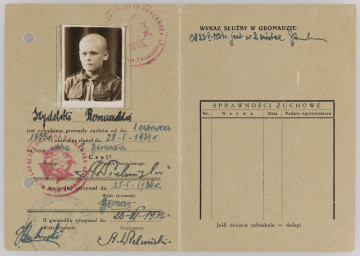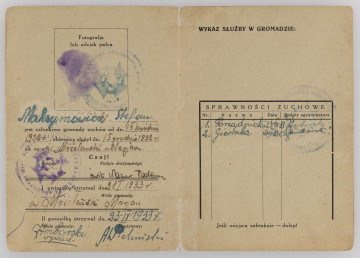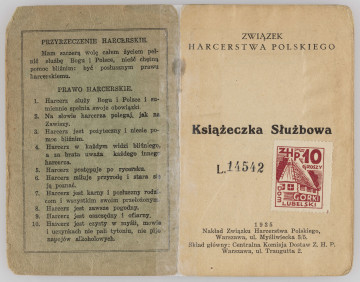
Certificate of the Polish Scouting Association ascertaining Romuald Szydelski’s membership
1933
National Museum in Lublin
Part of the collection: Memorabilia related to education and scouting in Lublin 1918–1944
The idea of scouting, which reached Polish territories at the beginning of the 20th century, quickly gained popularity among a nation preparing to fight for the country’s independence. The physical, moral and social development of youth seemed particularly attractive. The importance of scouting increased after independence was regained.
In order to unify the activities of scout organisations that operated in Poland until 1918, a congress was summoned in Lublin in November of that year, at which the scouting institutions merged into one organisation called the Polish Scouting Association. The consolidation process was finally completed in 1920, and the ZHP became one of the founding members of the World Organisation of the Scout Movement. The Chief of State and then successive presidents of the Republic of Poland patronaged the Association.
The General Assembly of the Polish Scouting Association in 1920 gave direction to the scouting activities. The need for a wider use of various forms of physical activity was emphasised, especially outdoor games, excursions and field athletics. In the interwar period, scouts began to practice various sports and tourism disciplines and also worked for the benefit of the community. In 1936, the ZHP was recognised as an association of higher utility.
In 1939, the scouting movement included around 200,000 members in 17 male scout regional branches (choragiew) and 15 female scout regional branches.
On September 27th, 1939, the management of the Association decided to join the conspiracy and adopt the code name ‘Gray Ranks’; the leaders were Florian Marciniak, Stanisław Broniewski ‘Orsza’ and Leon Marszałek. In 1945, by the order of the last head of the Polish Scouting Association, it once again operated openly.
The Association’s service book not only certified the membership, assignment and list of service of a given scout, but also collected information about his achievements: acquired skills (Stefan Maksymowicz obtained the skills of, among others, a squire, cook, aviator, rower, collector, cyclist, tracker, runner and swimmer), degrees obtained in organisational trials (Stefan Maksymowicz was appointed intelligence officer on March 15, 1939), sports badges awarded, as well as information recorded about the scout’s health and summer camps in which the owner of the book participated.
Author / creator
Dimensions
cały obiekt: height: 17 cm, width: 13,1 cm
Object type
document
Technique
stamping
Material
paper, photographic print paper, feather, ink, ink
Creation time / dating
Creation / finding place
Owner
The National Museum in Lublin
Identification number
Location / status

1933
National Museum in Lublin

1932 — 1933
National Museum in Lublin

1936
National Museum in Lublin
DISCOVER this TOPIC
Museum of King Jan III's Palace at Wilanów
DISCOVER this PATH
Educational path